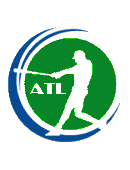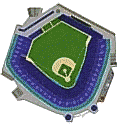
There
are no league restrictions or
regulations on normal player usage in the ATL. Every player is a
full-time player. That is the prime rule.
There are no league constraints on how you, as Owner and General
Manager, develop your
roster. You can have on your roster any group of 35 players that you
can draft, sign or trade for. However, having a well-rounded roster is
part of winning a pennant. It will be best to have a roster strategy
that includes at least 3 players rated to play catcher, shortstop,
second base and centerfield. These are the most important positions on
the field, and players who can play these positions well are at a
premium. It is also a good strategy to have some balance on the
pitching staff between right-handers and left-handers. But the bottom
line is that the league does not force any requirement on you. You are
free to experiment.
There are no league constraints on how you, as Field Manager, use your
players. The players can be played at any position, but they will
perform best in the role they are set up for. The game will handle
players used out of position by penalizing them appropriately. It is
all within the game mechanics, and only hinted at by the DMB Help
files, so experience is the best teacher in this regard. The best
strategy is to be prepared, and only use players in the role they are
meant to be used in. For the specifics of what the DMB Help file says
about this topic, read here:
- You can use a player at a defensive position for which he is not
rated,
but his performance will
suffer. How much? It depends.
- Players can make a relatively
painless transition to an easier position that is similar to one
they're already rated for. The penalties are much greater for moving to a very
different position that is also more difficult to play.
- For example, a CF can play LF or RF without suffering much at
all. Both positions are similar and easier than the one he's rated for.
A LF or RF moving to CF has a more difficult time because there's more
ground to cover. Similarly, a move from SS to 2B won't cost you too
much, while a move from 2B to SS will hurt more. And the moves that will hurt the most are
(a) from any position to catcher, (b) a catcher moving to any position
except 1B, and (c) a 1B moving to CF or another infield position.
- How will these penalties show up? In lots of ways. More balls in
their zones will go for hits.
They'll make more errors.
Guys without outfielder throwing or catcher throwing ratings will be easier to run on. Unrated
catchers will have more passed balls.
Unrated middle infielders won't
start as many double plays on balls hit to them, and they won't turn two as often when
they're the pivot man on the play. Pitchers without hold ratings will
be easier to run on.
- You might ask why we apply penalties even when a player is moving
to a less difficult position. Couldn't a top-rated SS play 2B as well
or better than the average 2B? In the many years that we've been
assigning fielding ratings, we've seen a lot of players get higher
ratings when they make the transition from a harder position to an
easier one (especially SS -> 2B, 3B -> 1B, and CF -> LF), but
we've also seen plenty of cases where the player needed some time to
learn how to play the new position.
- Every position requires
mastery of a different set of skills. A CF moving to RF needs to learn
how to play the caroms on balls hit down in the corner. A 3B needs
great reflexes to handle the hot smashes that come his way, and that
might not be the strong suit of a middle infielder moving to 3B. A SS
moving to 2B must learn how to make the pivot with his back to the
runner.
- If our out-of-position adjustments assumed that every player
could instantly adapt to a new position, even an easier one, we think
it would create too many opportunities for managers to abuse the game
by moving players around in ways that real-life managers would never
get away with. So the game imposes penalties of varying degrees on all
out-of-position players.
- real-life managers sometimes ask position players to throw an
inning on the mound to save the bullpen in a blowout, and sometimes
these players manage to retire a few hitters. Overall, they don't do
very well, and you'll find that the same is true if you try this in DMB.
So we see that although we can put any player anywhere on the diamond
we want, we will get
better results if we do not force players into situations they did not
usually find themselves.
What is true for the real baseball teams is even more so here where
every player is a star. Even the lesser players in the ATL were
at least franchise stars when they played the game. Every ATL game is
an All-Star game. It will take a good roster strategy and a good
managing strategy to have a good season. Having good players in
the lineup is not enough -- every team in this league has good players
in the lineup.
Injuries are the bane of every team's season, and injuries are the
great unknowable future catastrophe awaiting every team in every next
game. Nobody can predict when an injury will strike, or how long a
player will go without an injury. Seasons and careers have been
unmade because of injury. Injuries have shaped many a player's
career. That is real life. Here in the ATL we use the Random
Injury setting to simulate just that black void of undetermined injury
potential. None of us knows which player will get struck down by a
season-crushing injury. One thing we do have the luxury of, is that no
injury will affect a player's career in any way except to shorten the
amount of games the player would otherwise have played.
Managing injuries is your task. You must decide whether to put a
player
on the Disabled List or carry that player on a roster spot even though
the player cannot play. Disabling a player may lengthen the time a
player is out of action because league regulations state that Roster
Changes can only be made between series. That means you may not be able
to Activate a player immediately after the injury is over -- you have
to wait until the current series of games is over and put in the
Activate order for between-series. Since we play 4-day series, the time
a player is out could be lengthened by up to 4 days, or a multiple of 4
days if you forget to Activate the player on time. You can consider the
extra time on the Disabled List as special injury rehabilitation time.
You cannot have a
standing order for the Commissioner to activate a player as soon as
possible, it is your responsibility as Owner, General Manager and Field
Manager to watch over every aspect of your team and its players.
Players traditionally have certain roles, and the players in this set
are depicted in the roles they played for the time periods depicted by
the player set. However, you have complete
control over this aspect of your team as well. You can choose to change
the role of any player on your roster. Most commonly we will see
starting pitchers used as relief pitchers simply because there are not
enough good relief pitchers in this player set. Or put another
way, there are an abundance of good starting pitchers in this player
set, more so than relief pitchers. Many teams have more than enough
starters and are short on relievers, and so the roles shall be changed.
For pitchers who do have a relief rating there will be no penalties for
playing out of position -- because they are rated at the position of
relief pitcher. For those pitchers without a relief rating, or for the
opposite -- those relievers without a rating as starting pitcher, the
normal penalties for playing out of position will apply.
How do you change their roles? Simply use the Manager Profile to
define the role you want a pitcher to play. There are slots for Setup
Men, Closers, Mopup guys, Long Relievers, Spot Starters and your normal
rotation. Here is a good place to quote the DMB Help file about
some very important settings on the pitcher pages that you have
complete control over -- and will decide how the computer uses your
pitchers during Autoplay games (during Netplay games you have complete
and utter control over your players except for Roster Changes and
Roster Mods -- which are not allowed during Netplay).
The following is very important, please read it all the way
through. At the bottom of the rotation box in the roster/manager
profile section, there are 3 additional boxes. These three boxes
control
very powerful functions:
- Select Time mode to have
the
computer manager do its best to make sure
that every starting pitcher and reliever gets exactly as many starts
and relief appearances as they had in real life. This mode is
appropriate for teams that have their real-life rosters intact, and it
should NOT
be used when you are playing a season with newly-drafted
rosters.
- NOTE: In Time mode,
the computer manager ignores
your rotation.
Instead, it looks at how many starts each pitcher is limited to in the
playing time limits section of your profile (this is usually set to
match his real-life starts) and spreads those starts evenly over the
season. The pitcher with the most real-life starts will be selected on
opening day even if he is not listed in the #1 slot in the rotation.
The computer manager will choose starting pitchers who are not in the
rotation if their games started limit is greater than zero.
- Select Strict mode to
have the
computer manager use your pitchers in
the order they appear in the starting rotation. The computer manager
will choose another starting pitcher only if a rotation starter is
injured when his turn comes up (or if
you are using the Spot Start Percentage rating for Spot Starters, and
that percentage chance has happened).
- Select Skip to have the
computer manager use your pitchers in the order
they appear in the starting rotation but skip to the #1 starter when
one or more off-days have left him rested enough to start before his
turn. The computer manager will choose another starting pitcher only if
a rotation starter is injured when his turn comes up.
- Rotation Size You can
enter a number to tell the computer
manager how
big the starting rotation should be. Modern teams almost always use a
five-man rotation. Four-man rotations were common until the 1970s, and
smaller rotations were the norm a hundred years ago.
- Although the saved starting rotation is ignored in the Usage mode of Time, it is still important to set
your rotation size in order to get
the most out of your starting pitchers. If a pitcher made 40 starts,
the rotation size must be set no higher than 4 in order for him to
reach his maximum number of starts. If you set the size at 5, he won't
make more than 33 starts in a 162-game season.
- The Rotation Size is
also
used to enforce a Strict or Skip rotation.
- Next Starter. When you
are using either the Strict
or Skip rotation mode, this
value
tells the computer manager which rotation slot is due to start the next
game. You can change this if
you want to juggle your rotation during a
season.
- NOTE: When the computer
manager selects a starting pitcher in Strict
or Skip mode, it simply
chooses the
pitcher who is in the Next
starter slot. It doesn't look at who was used in recent games, so it's up to you to make sure that
the Next starter value is set appropriately
if you are mixing human-managed games and computer-managed games for
this team.


 There
are no league restrictions or
regulations on normal player usage in the ATL. Every player is a
full-time player. That is the prime rule.
There
are no league restrictions or
regulations on normal player usage in the ATL. Every player is a
full-time player. That is the prime rule. The
baseball park is like no other sport's field. Nowhere do the playing
fields have a life of their own, and influence the game as much as in
baseball. Nowhere else does the field itself become legendary.
The
baseball park is like no other sport's field. Nowhere do the playing
fields have a life of their own, and influence the game as much as in
baseball. Nowhere else does the field itself become legendary.